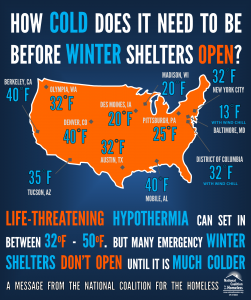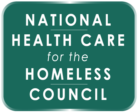Cold-Related Injuries

Resources
Winter is Coming Infographic | 2020
This winter presents many challenges to organizations providing care for people experiencing homelessness. A complement to the issue brief, this infographic highlights six of these challenges and links to the three webinars in our Winter is Coming series.
COVID-19 & the HCH Community: Six Crises Leading into Winter 2020 | 2020
This issue brief focuses on the challenges of the upcoming winter season—COVID-19, flu season, winter weather, evictions, social upheaval, and collective trauma—and the essential actions that emergency response systems, state/local governments, and direct service organizations need to take in order to protect people experiencing homelessness as temperatures drop.
Winter is Coming: Cold Weather & Disasters | 2020
This webinar addresses how to prepare, plan, and respond to extreme cold weather and the corresponding health issues for those living outdoors, as well as natural disasters such as hurricanes and fires.
Developing a Cold Weather Sheltering Plan for People Experiencing Homelessness | 2012
This webinar will provide an overview of cold-weather injuries and illnesses common to people who are experiencing homelessness and explore a program model that provided 11,195 guest-nights in over 150 emergency warming centers to residents of Boulder, Colorado, in the 2010-11 winter season.
Winter Homeless Services: Bringing Our Neighbors in from the Cold | 2010
Seven hundred people experiencing or at risk of homelessness are killed from hypothermia annually in the United States. Forty-four percent of the nation’s homeless are unsheltered. From the urban streets of our populated cities to the remote back-country of rural America, hypothermia – or subnormal temperature in the body – remains a leading, critical and preventable cause of injury and death among those experiencing homelessness. The National Coalition for the Homeless has published Winter Homeless Services: Bringing Our Neighbors in from the Cold to raise awareness of the dangers and consequences of hypothermia on people experiencing homelessness.
Quick Tips for Shelter & Outreach Providers | 2010
Quick Tips for shelter providers/outreach staff for keeping people warm in cold weather and recognizing and dealing with hypothermia and frostbite. Health Care for the Homeless Network, Public Health – Seattle & King County.
Exposure-Related Conditions: Symptoms & Prevention Strategies | 2007
Exposure-related conditions are a constant reality faced by homeless individuals who spend most days and many nights outside. Without shelter against the elements, they are dependent on mild temperatures and dry weather for a tolerable existence. And while some people who live on the streets may have tents or cardboard structures to provide a modicum of protection and privacy, they are still susceptible to hypo- or hyperthermia as well as associated maladies including frostbite, sunburn, and heat exhaustion. Those who are very young, old, malnourished or exhausted are at increased risk of serious health problems from exposure to temperature extremes. This issue discusses signs and symptoms of cold- and heat-related pathologies and how to prevent them.
A Case of Trench Foot in a Homeless Woman | 2007
This article describes a cold-related tissue injury that may be overlooked by healthcare practitioners who treat homeless clients: trench foot. Trench foot is a preventable condition which can be mitigated by early intervention but which, because it occurs at above-freezing temperatures, might go unrecognized and untreated. The sequelae of unrecognized and untreated trench foot can be dire.
